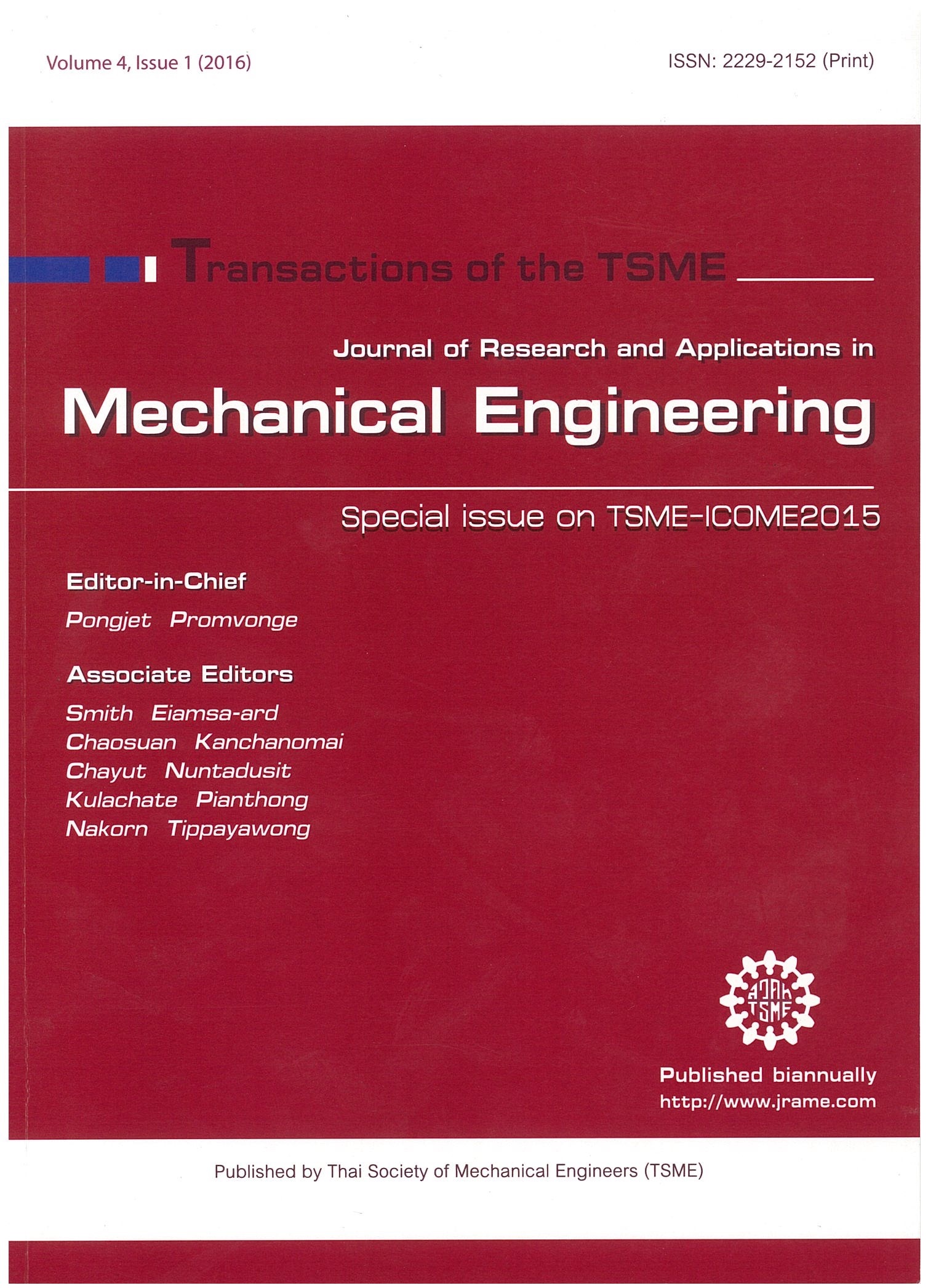Germinated Bambara groundnut manufacturing by hot air fluidized bed drying technique
Main Article Content
Abstract
The paper aims to study the manufacturing of germinated bambara groundnut by hot air fluidized bed drying (HA) technique. The desirable moisture content was 13-15% (dried basis). The suitable germination method and the minimum superficial air velocity of fluidization (Vmin) were determined. The drying kinetics of HA (90, 130 and 150°C) were compared with sun drying (SD). Moreover, the dried product qualities, i.e. the microorganism quantity, GABA content, color and the consumer satisfaction, were also studied. Study results showed that the germination from unshell bambara groundnut (UBG) got the maximum value of germination rate and GABA content. The microorganism quantities after germination were higher than 7,000,000 CFU/g. The Vmin was 15.8 m/s. The HA had the higher drying rate than SD and could decrease the microorganism quantities to the safety level. The GABA content significantly changed after HA above 130°C. The germinated UBG color after HA was darker than the commercial groundnut. The consumer satisfied the odor, color and the texture of the germinated UBG after HA at 130 and 150°C.
Article Details
This work is licensed under a Creative Commons Attribution-NonCommercial-ShareAlike 4.0 International License.
References
[2] Linnemann, A.R. Bambara groundnut (Vigna subterranean (L.) Verdc.), Tropical Agriculture, Vol. 12(7), 1987, pp. 9-25.
[3] Mkandawire, C.H. Review of bambara groundnut (Vigna subterranean (L.) Verdc.) production in sub-Sahara Africa, Agricultural Journal, Vol. 2(4), 2007, pp. 464-470.
[4] Sunte, J., Srijesdaruk, V. and Tangwongchai, R. Effects of soaking and germinating process on gamma-aminobutyric acid (GABA) content in germinated brown rice (Hom mali 105), Agricultural Science Journal, Vol. 38(6), 2007, pp. 103-106.
[5] Khampang, E., Kerdchoechuen, O. and Laohakunjit, N. Change of chemical composition of rice and cereals during germination, Agricultural Science Journal, Vol. 40(3), 2009, pp. 341-344.
[6] Elliott, K.A.C. and Hobbiger, F. Gamma aminobutyric acid: Circulatory and respiratory effects in different species: Re-investigation of the anti-strychnine action in mice, Journal of Physiology, Vol. 146(1), 1959, pp. 70-84.
[7] Oh, C.H. and Oh, S.H. Effect of germinated brown rice extracts with enhanced levels of GABA on cancer cell proliferation and apoptosis, Journal of Medicinal Food, Vol. 7(1), 2004, pp. 19-23.
[8] Piernas, V. and Guiraud, J.P. Microbial hazards related to rice sprouting, International Journal of Food Science&Technology, Vol. 32(1), 1997, pp. 33–39.
[9] Komatsuzaki, N., Tsukahara, K., Toyoshima, H., Suzuki, T., Shimizu, N. and Kimura, T. Effect of soaking and gaseous treatment on GABA content in germinated brown rice, Journal of Food Engineering, Vol. 78(2), 2007, pp. 556-560.
[10] Srisang, N., Prachayawarakorn, S., Soponronnarit, S. and Varanyanond, W. Fluidized bed drying of germinated brown rice, paper presented in the 4th International Conference on Innovations in Food Processing Engineering and Technology, Asian Institute of Technology, 2008, Bangkok, Thailand.
[11] Chungcharoen, T., Prachayawarakorn, S., Soponronnarit, S. and Tungtrakul, P. Effect of drying temperature on drying characteristics and quality of germinated rices prepared from paddy and brown rice, Drying Technology, Vol. 30(16), 2012, pp. 1844-1853.
[12] Raikham, C., Prachayawarakorn, S., Nathakaranakule, A. and Soponronnarit, S., Influences of pretreatments and drying process including fluidized bed puffing on quality attributes and microstructural changes of banana slices, Drying Technology, Vol. 33(8), 2015, pp. 915-925.
[13] Maturin, L. and Peeler, J.T. Bacteriological Analytical Manual: Aerobic Plate Count, 8th edition, Center for Food Safety and Applied Nutrition, 1998, FDA, Silver Spring, MD.
[14] Knecht, R. and Chang, J.Y. Liquid chromatography determination of amino acids after gas-phase hydrolysis and derivertization with (Dimethylamins) azobenzenesulfonyl chloride, Analytical Chemistry, Vol. 58(12), 1986, pp. 2375-2379.
[15] Lin, J.K. and Wang, C.H. Determination of urinary amino acids by liquid chromatography with dabsyl chloride, Clinical Chemistry, Vol. 26(5), 1980, pp. 579-583.
[16] Chungcharoen, T., Prachayawarakorn, S., Soponronnarit, S. and Tungtrakul, P. Effect of drying temperature on drying characteristics and quality of germinated rices prepared from paddy and brown rice, Drying Technology, Vol. 30(16), 2012, pp. 1844-1853.
[17] Caicedo, G.R., Ruiz, M.G., Marqués, J.J.P. and Soler, J.G. Minimum fluidization velocities for gas–solid 2D beds, Chemical Engineering and Processing: Process Intensification, Vol. 41(9), 2002, pp. 761-764.
[18] Thai Industrial Standards Institute. Thai community product standard: rice snack chip cracker (TCPS 107/2003), 2003, p. 5, (in Thai).
[19] Jaiboon, P., Prachayawarakorn, S., Devahastin, S. and Soponronnarit, S. Effects of fluidized bed drying temperature and tempering time on quality of waxy rice, Journal of Food Engineering, Vol. 95(3), 2009, pp. 517-524.
[20] Chungcharoen, T., Prachayawarakorn, S., Tungtrakul, P. and Soponronnarit, S. Quality attributes of germinated high amylose and waxy rices in superheated steam and hot air dryings, Drying Technology, Vol. 33(7), 2015, pp. 876-885.



